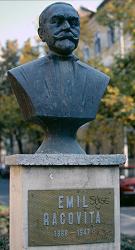Muzeul de Speologie "Emil Racoviţă"
Speleology Museum "Emil Racoviţă"
Useful Information
| Location: |
Str Sextil Puşcariu Nr. 8, Cluj.
(46.77115993088134, 23.58765803593513) |
| Open: |
All year Tue-Fri 12-16. [2011] |
| Fee: |
free. [2011] |
| Classification: |
 Cave and Karst Museum Cave and Karst Museum
|
| Light: |
 Electric Light Electric Light
|
| Dimension: | |
| Guided tours: | |
| Photography: | |
| Accessibility: | |
| Bibliography: | |
| Address: |
Muzeul de Speologie "Emil Racoviţă", Str Sextil Puşcariu Nr. 8, 400006 Cluj-Napoca, Tel: +40-264-430601, Tel: +40-264-591273.
E-mail: |
| As far as we know this information was accurate when it was published (see years in brackets), but may have changed since then. Please check rates and details directly with the companies in question if you need more recent info. |
|
History
| 1998 | museum founded. |
| 31-OCT-2003 | new building inaugurated. |
Description

The collections with the remains of Emil Racoviţă were formerly exhibited at the Biology and Geology Institute at the University of Cluj. Now it has moved to a new building and is now open as Muzeul de Speologie "Emil Racoviţă" (Speleology Museum "Emil Racoviţă").
The building was used as a prison during the Middle Ages. The most famous inmate was Baba Novac (Starina Novak, Old Novak), a Serbian Hajduk who fought in many battles against the Turks invading Europe. He had a strong personality and military prowess, which made him the leader of an efficient guerilla force. But he was accused of treason by Giorgio Basta, a former ally who became a rival. He was imprisoned here and executed on 05-FEB-1601 by being burnt alive for 1.5 hours.
The museum shows primarly the remains of the work of Emil Racoviţă so it is not only named after him, it is also dedicated to him as the founder of the Romanian speleology. He even introduced the term in the language. But he was biospeleologist, and he found this term much too long so he decided to shorten biospeleology to biospeologie. As a result the science of speleology is called speologie in Romanian.
The museum exhibits a notebook with notes he made during the time he studied at the Sorbonne University in Paris. Other items are from his participation on the Belgian expedition to Antarctica, like a Zeiss microscope and a Lihnof camera. A projector and slides were used by him when he held the general biology course at the University of Cluj. There are the original drawings which illustrated his scientific papers. And there are numerous office items and personal items too.
- See also
 Emil Racoviţă
Emil Racoviţă Search DuckDuckGo for "Muzeul de Speologie "Emil Racoviţă""
Search DuckDuckGo for "Muzeul de Speologie "Emil Racoviţă"" Google Earth Placemark
Google Earth Placemark Speleologist "Emil Racovita" Museum - Cluj-Napoca (visited: 20-JUN-2011) (
Speleologist "Emil Racovita" Museum - Cluj-Napoca (visited: 20-JUN-2011) (
 )
) Emil Racoviţa Institute of Speleology Museum in Cluj-napoca, Romania - Lonely Planet (visited: 21-JUN-2011)
Emil Racoviţa Institute of Speleology Museum in Cluj-napoca, Romania - Lonely Planet (visited: 21-JUN-2011) Muzeul De Speologie Emil Racovita Cluj-Napoca - Hotels near Muzeul De Speologie Emil Racovita Cluj-Napoca , Romania (visited: 21-JUN-2011)
Muzeul De Speologie Emil Racovita Cluj-Napoca - Hotels near Muzeul De Speologie Emil Racovita Cluj-Napoca , Romania (visited: 21-JUN-2011) Muzeul de Speologie Emil Racovita - Cluj | Locuri Bantuite (visited: 21-JUN-2011) (
Muzeul de Speologie Emil Racovita - Cluj | Locuri Bantuite (visited: 21-JUN-2011) ( )
) Muzeul de Speologie Emil Racovi?a | Ora?ul Cluj-Napoca (visited: 21-JUN-2011) (
Muzeul de Speologie Emil Racovi?a | Ora?ul Cluj-Napoca (visited: 21-JUN-2011) ( )
) Muzeul de Speologie Emil Racovita - Enciclopedia României - prima enciclopedie online despre România (visited: 21-JUN-2011) (
Muzeul de Speologie Emil Racovita - Enciclopedia României - prima enciclopedie online despre România (visited: 21-JUN-2011) ( )
)
 Index
Index Topics
Topics Hierarchical
Hierarchical Countries
Countries Maps
Maps